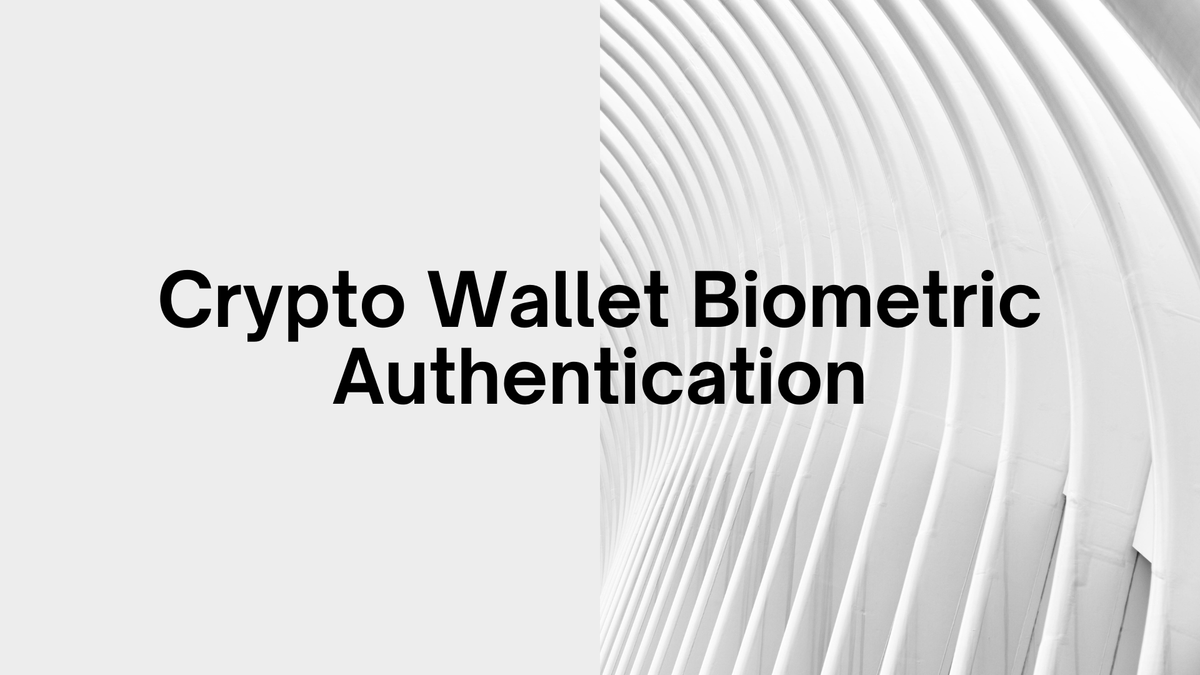Crypto Wallet Biometric Authentication

Introduction
Crypto wallets, the essential tools used to store private keys and manage digital assets, are now facing increasing threats from phishing, malware, SIM swaps, and social engineering attacks. Traditional methods like PINs and passwords are no longer sufficient in the face of sophisticated cyber threats. This has led to the emergence of biometric authentication as a promising security layer for crypto wallets.
Biometric authentication leverages unique physiological or behavioral traits, like fingerprints, facial features, or voice patterns, to authenticate users. This article explores the architecture, advantages, challenges, and future outlook of biometric authentication in the context of crypto wallets.
What Is Biometric Authentication?
Biometric authentication refers to the process of verifying a user’s identity based on their biological traits. The most common types include:
- Fingerprint recognition
- Facial recognition
- Iris scanning
- Voice recognition
- Behavioral biometrics (e.g., typing patterns, touch behavior)
Unlike passwords or PINs, biometric data is inherently unique and difficult to replicate, making it a strong form of identity verification.
How Crypto Wallets Use Biometrics
There are two main types of crypto wallets: custodial and non-custodial. Biometric authentication can be implemented differently depending on the type of wallet:
- Custodial Wallets: These are wallets managed by third-party platforms like Coinbase or Binance. Biometric authentication in these systems is usually part of the mobile app's login process and serves as an additional layer alongside passwords or 2FA.
- Non-Custodial Wallets: These wallets allow users full control of their private keys (e.g., MetaMask, Trust Wallet). Biometric authentication in non-custodial wallets often protects the seed phrase, signing of transactions, or access to the wallet application itself.
Some popular wallets using biometrics include:
- Trust Wallet – Offers Face ID or fingerprint unlock on mobile devices.
- MetaMask Mobile – Supports biometric authentication for login and transaction confirmation.
- ZenGo – Uses facial biometrics for secure keyless wallet access.
Biometric Authentication Architecture in Crypto Wallets
The implementation of biometrics generally follows these steps:
- Enrollment: The user’s biometric data (e.g., fingerprint or face) is captured and securely stored on the device in a Trusted Execution Environment (TEE) or Secure Enclave.
- Template Creation: The biometric sample is converted into a mathematical representation or template. This is what is compared later, not the raw image or voice.
- Matching: When authentication is needed, a new sample is taken and matched against the stored template. If it matches, access is granted.
- Access Control: Based on successful verification, the wallet either unlocks access or authorizes a transaction.
This local processing, known as on-device biometric authentication, ensures that sensitive biometric data is not transmitted over the internet, greatly enhancing privacy.
Benefits of Biometric Authentication in Crypto Wallets
1. Enhanced Security: Biometric traits are unique to each individual, making it nearly impossible for hackers to gain access unless they have physical control of the device and the user. Unlike passwords, biometrics cannot be forgotten, guessed, or easily stolen.
2. User Convenience: Users no longer need to memorize complex passphrases or enter long passwords every time they access their wallet. With a glance or a touch, they can authenticate quickly and efficiently.
3. Phishing Resistance: Because biometric authentication doesn’t rely on credentials that can be entered into a phishing site, it reduces the risk of falling victim to such attacks.
4. Transaction Confirmation: Biometrics can be used to confirm specific high-value or high-risk transactions, acting as a “soft multi-signature” mechanism.
5. Keyless Wallets: Solutions like ZenGo employ biometric cryptography to avoid traditional seed phrases altogether. This reduces the burden on users while maintaining security.
Challenges and Limitations
1. Device Dependence: Biometric authentication is only as good as the device it runs on. If the user loses access to their smartphone or if the sensor fails, recovery mechanisms must be robust.
2. False Positives/Negatives: Though rare, biometric systems are not infallible. False positives (unauthorized access granted) and false negatives (authorized access denied) can occur.
3. Lack of Standardization: Not all wallets or blockchains have standardized ways to integrate biometrics. This leads to fragmented user experiences and potential security inconsistencies.
4. Privacy Concerns: Storing biometric data, even locally, raises privacy questions. While most systems avoid cloud storage of biometric data, concerns persist about how securely the templates are protected.
Use Cases in the Crypto Ecosystem
1. Secure Key Recovery: If a user loses their device, some wallets allow recovery using biometric authentication tied to cloud backup systems. This reduces friction in onboarding and recovery.
2. Multi-Factor Authentication (MFA): Biometrics can serve as one factor in MFA setups, strengthening the overall security posture. For example, a wallet may require both Face ID and a hardware wallet signature.
3. DeFi Access and Governance: Biometric authentication can be used for user authentication in DeFi apps, enabling safer staking, voting, and transaction approvals from mobile interfaces.
4. Biometric Wallet Cards: Hardware wallets like Arculus are exploring credit-card-shaped devices with built-in fingerprint scanners to confirm ownership offline.
Real-World Examples
- ZenGo: ZenCo implements facial recognition and threshold signatures instead of private keys.
Website: - Ledger (planned): Considering biometric upgrades for its next-gen hardware wallets.
News: https://cointelegraph.com/news/ledger-hardware-wallet-integrates-biometric-authentication - Trust Wallet: Trust Wallet offers device-native Face ID or fingerprint authentication.
Future Outlook
1. Biometric + Blockchain Identity: We may see the merging of decentralized identity (DID) frameworks with biometric authentication, enabling users to carry biometric-based identities across platforms and wallets.
2. Zero-Knowledge Biometrics: Emerging cryptographic techniques like zero-knowledge proofs (ZKPs) could enable biometric verification without revealing the biometric data itself.
3. Biometric Hardware Wallets: Next-gen hardware wallets will likely feature biometric modules (like fingerprint readers or iris scanners), combining cold storage with the ease of mobile biometrics.
4. Cross-Wallet Biometric Standards: Efforts by organizations like FIDO Alliance may push for interoperable biometric standards across crypto wallets, improving security and user experience.
Conclusion
Biometric authentication is poised to become a cornerstone in the evolution of secure crypto wallet access. It balances usability with enhanced protection, making it easier for both seasoned crypto users and newcomers to securely interact with their digital assets.
However, biometric authentication must be thoughtfully implemented, with an emphasis on local processing, data encryption, and robust recovery mechanisms, to avoid introducing new vulnerabilities. As the crypto industry matures, we can expect more wallets to adopt biometrics, not just as a feature of convenience, but as a necessity for trust and long-term usability.
References
- https://www.nist.gov/programs-projects/biometrics
- https://fidoalliance.org/
- https://zengo.com/security/
- https://www.zdnet.com/home-and-office/networking/telstra-explores-blockchain-biometrics-to-secure-smart-home-iot-devices/
- https://www.getarculus.com/
- https://www.ledger.com/academy/topics/ledgersolutions/ledger-hardware-devices-explained-the-10-year-evolution
- https://en.wikipedia.org/wiki/Zero-knowledge_proof
- https://trustwallet.com/
MITOSIS official links:
GLOSSARY
Mitosis University
WEBSITE
X (Formerly Twitter)
DISCORD
DOCS



Comments ()